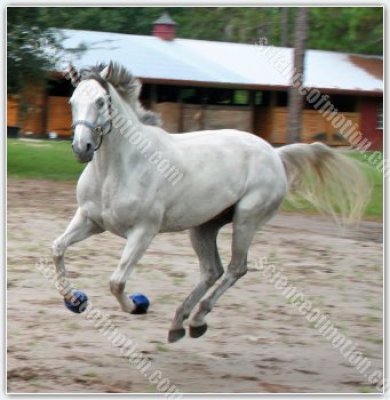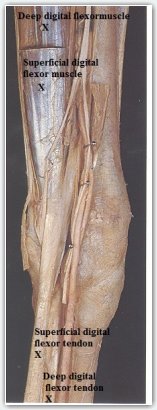Mechanoresponsiveness PT 7
Mechanoresponsiveness
Part 7
Jean Luc Cornille

At the level of muscles, tendons, fasciae, ligaments, nature has developed a sophisticated cycle or energy saving and reuse. The concept is easy to understand focusing on the long tendons of the lower leg, The distal limb of the horse has been shown to function like a pogo stick, storing and returning energy in long, spring-like tendons throughout the gait cycle (Biewener, 1998 Wilson et al., 2001). It demands less energy for a tendon to elongate and shorten than for a muscle. “The elastic energy stored in and recovered from tendons during cyclical locomotion can reduce the metabolic cost of locomotion (Cavagna et al., 1977; Alexander, 1988; Roberts et al., 1997).
Wilson et al., 2001). It demands less energy for a tendon to elongate and shorten than for a muscle. “The elastic energy stored in and recovered from tendons during cyclical locomotion can reduce the metabolic cost of locomotion (Cavagna et al., 1977; Alexander, 1988; Roberts et al., 1997).
When properly set, the phenomenon of storage and reuse of elastic strain energy, is so efficient that it greatly reduces the work of the associated muscles. “The ability of the muscle-tendon units to recover elastic strain energy is apparently energetically so advantageous that the most economical stride frequency in running may be set by this key component alone.” (Paul C. LaStayo, PT, PhD. John M. Woolf, PT, MS, ATC. Michael D. Lewek, PT. Lynn Snyde-Mackler, PT, ScD. Trugo Relch, BS. Stan L. Lindstedt, PhD. Eccentric Muscle Contractions: Their contribution to injury, prevention, rehabilitation, and sport. Journal of Orthopaedic & sports physical therapy. 557-571. Volume 33, NUMBER 10, October 2003)
There are many different architectures allowing many different nuances in the concept of storage and reuse of elastic strain energy. For instance, just for the long tendons of the lower legs, the muscle that is ensuring proper tension of the deep digital flexor tendon is constructed with longer fibers as the deep digital flexor tendon is less elastic. By contrast, the muscle ensuring proper tension of the superficial digital flexor tendon has shorter fibers as the superficial flexor tendon is more elastic. During the first half of the stride, each muscles optimize the storage of elastic strain energy in the tendon ensuring proper tension of the correspondent tendon. Releasing these muscles would alter their capacity to ensure proper tension of the correspondent tendon and consequently the power and amplitude of the stride. The thought that greater amplitude in the limbs movements can be achieved releasing, or elongating limbs muscles is inconsistent with actual knowledge.
The concept of elastic energy stored and reused is not limited to the long tendons of the lower legs. Muscles such as the serratus ventralis of the forelegs or the tensor fasciae latae of the hind legs are surrounded by broad shits of elastic tissues acting like tendons and named aponeurosis. The elastic strain energy stored in the aponeurosis of the propulsive hind leg during the first half of the stride is a main force bringing the hind limb forward during the swing. The fundamental principle of locomotion is not stretching, lengthening or release.  It is instead, muscles ensuring proper tension of the tendons and aponeurosis in order to maximize storage and recovery of elastic strain energy.
It is instead, muscles ensuring proper tension of the tendons and aponeurosis in order to maximize storage and recovery of elastic strain energy.
The importance of muscles ensuring proper tension of the tendon goes far beyond efficient locomotion. When several tendons are attached to a joint, they are part of the joint’s stability. In fact, the joint alone would not be able to support the intensity of the stresses. When the muscles ensuring proper tension of the tendons are elongated, stretched or released, their ability to ensure proper tension of the tendon is compromise as well as the stability of the join.
The concept of energy stored and recovered is even broader than the tendons and aponeurosis as the muscles have the capacity to store and recover elastic strain energy even in the absence of tendons. “Apart from the role of tendons and collagen in energy storage, the muscle itself stores and recovers elastic strain energy, as elastic strain energy can occur in the absence of tendons” Sound and efficient locomotion demands that within the muscles’ belly, contractile cells and tendinous components are tuned to the stride frequency. There is a frequency or cadence that is proper to each horse and sound locomotion can only be achieved respecting the horse’s frequency. When trainers and judges advise “more forward,” they think at superficial level and create damages at deeper levels.
The purpose of this series, mechanoresponsiveness is making riders aware that superficial theories might appears sound and logical as long as they are thought through at superficial level. They became questionable and even damaging when the horse’s structure is studied at a deeper level. The problem is that the horse’s deeper structures are the foundation of athletic performances and soundness. For instance, the concept of “hardening’ bones and tendons trotting on hard surface is promoted since centuries. At superficial level, the concept of increasing the bone density appears logical. Studies comparing horses submitted to high intensity training with horses submitted to moderated physical activity show thickening of subchondral bone on the group of horses submitted to intense training. At superficial level, thickening of the subchondral bone can be interpreted as stronger and therefore beneficial. However, the same study observed that high intensity training also led to loss of hyaline cartilage stiffness at sites where lesions are commonly observed. “Forces applied to a joint are dissipated through the entire osteochondral unit, which is composed of hyaline cartilage superficially, subchondral bone plate and cancellous bone.” (R. C. Mura y, S. Vedi, H. L. Birch, K. H. Lakhamni, A. E. Goodship, Subchondral bone thickness and remodeling are influenced by short term exercise in a sit-specific manner, Journal of Orthopaedic Research,19,[2001] 1035-1042). Instead of exposing the bone structure to more microcracks, increasing bone density can be done through appropriated used of eccentric contractions. This will be the subject of Mechanoresponsiveness part 8.
The horse industry is basically a sell business and superficial theories are packaged in convincing marketing strategies. The horse does not functions at superficial level. The elegance of athletic performances as well as the horse soundness demands education of deeper scales. Horse owners and riders are ultimately the horse’s protection and the science of motion provides the necessary knowledge.
Jean Luc Cornille 2015



 twitter
twitter facebook
facebook google
google stumbleupon
stumbleupon pinterest
pinterest linkedin
linkedin